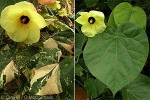Cook Islands Biodiversity Database
Species Page
Hibiscus tiliaceus
‘AuTree Hibiscus
Multimedia & Additional Resources
| Type | Description | Download |
| Wild form and variegated form | 60KB | |
| Ornamental variegated form | 102KB | |
| Wild form with fresh and old (red) flower | 58KB |
General Information
Cook Islands Distribution
| Southern Group: Present Makatea: Present | ||||||||
RR |
MG |
AT |
MK |
MT |
AK |
PL |
TK |
MN |
++++ |
++++ |
++++ |
++++ |
++++ |
++++ |
P |
+ |
- |
| Northern Group: Present | |||||
TN |
MH |
RK |
PK |
NS |
SW |
- |
P |
++ |
+ |
P |
P |
Pests & Hosts
| Relationship | Pests |
| Herbivorous pest | Adoretus versutus, |
| Herbivorous pest on Malvaceae, incl. | Anomis involuta, |
Scientific Taxonomy
Hibiscus tiliaceus Linnaeus
SYNONYMS: Hibiscus tiliaceus tiliaceus; Hibiscus tiliaceus hastatus [leaves 3-lobed with base round to acute, Bismarck - Societies, excl. Cooks]; Talipariti tiliaceum; Talipariti tiliaceum var. tiliaceum
TAXONOMY: PLANTAE; ANTHOPHYTA (=Angiospermae); MAGNOLIOPSIDA (=Dicotyledones); DILLENIIDAE; Malvales; MALVACEAE
More Information
SIGNIFICANCE NOTES -
POSITIVE SIGNIFICANCE: Medicine, Material (Fibre, Wood). Comments: MATERIAL: Old wood very fine, attractive, lasting, easily worked, hard and tough. Green through brown to almost black.
NEGATIVE SIGNIFICANCE: Invasive - moderate, Weed - moderate. Comments: Very common in damp volcanic areas from swamplands to mid-elevations. Forms a discontinuous belt around Rarotonga on the low inland slopes and valleys - a result of earlier forest clearance rather than invasion. Requires constant attention near horticultural fields, swamplands, and along streams.
GENERAL NOTE: It seems most likely that Hibiscus tiliaceus originated in Asia and initially spread westward across the Indian Ocean and eastward across the Pacific. One way or the other it very anciently reached the Americas where it now has a variety or subspecies or very closely-related species native on the tropical Pacific and Atlantic coasts. This tree of tropical America is variously named: Hibiscus pernambucensis Arruda 1810, Hibiscus tiliaceus pernambucensis, or Hibiscus tiliaceus var. pernambucensis depending on the interpretation of its status. The interesting case for it as a separate species is found at: http://www.mcapel.hpg.ig.com.br/galls/malvaceae/Hperntili/index_eng.html.
The seeds float in seawater and are viable for several months which probably accounts for its wide distribution, although as a very useful tree it was probably also introduced to islands where it was absent.
It might be native to the Society Islands, although on Mo'orea it appears in the pollen record in post-settlement samples only indicating that it was a Polynesian Introduction there [Parkes 1997]. However this species is commonly not found in modern pollen records indicating that its absence is not a reliable indicator of its presence in local vegetation. Plants of Hawaii (Wagner et.al.) notes that it is not possible to decide between native and Polynesian Introduced for Hawaii.
Vouchers & References
Vouchers:
Pukapuka: fieldspecimens, 2/2004, ID G.McCormack, and in the pre-Contact chants - an ancient introduction and name shows Eastern Polynesian influence (pers.comm. K.Salisbury).
References:
p.888 Wagner et al.- Flowering Plants of Hawaii
p.559 Neal - In Gardens of Hawaii
p.562 Hortus 3rd
p.571 Royal Hort. Soc. Index of Garden Plants
p.628 Tropica
p.2/416 A.C.Smith - Flora Vitiensis Nova
p.274 I Cheeseman - Flora of Rarotonga
p.73 Wilder - Flora of Rarotonga
p.358d Whistler - Ethnobotany of the Cook Islands
p.97 McCormack/Kunzle - Rarotonga's Mountain Tracks and Plants
Data Update History (information):
zTX, zB02, zM02, zupM03a, zD02, zupD05a
Web Resources
Citation Information
McCormack, Gerald (2007) Cook Islands Biodiversity Database, Version 2007.2. Cook Islands Natural Heritage Trust, Rarotonga. Online at http://cookislands.bishopmuseum.org. ![]()
Please refer to our use policy.

